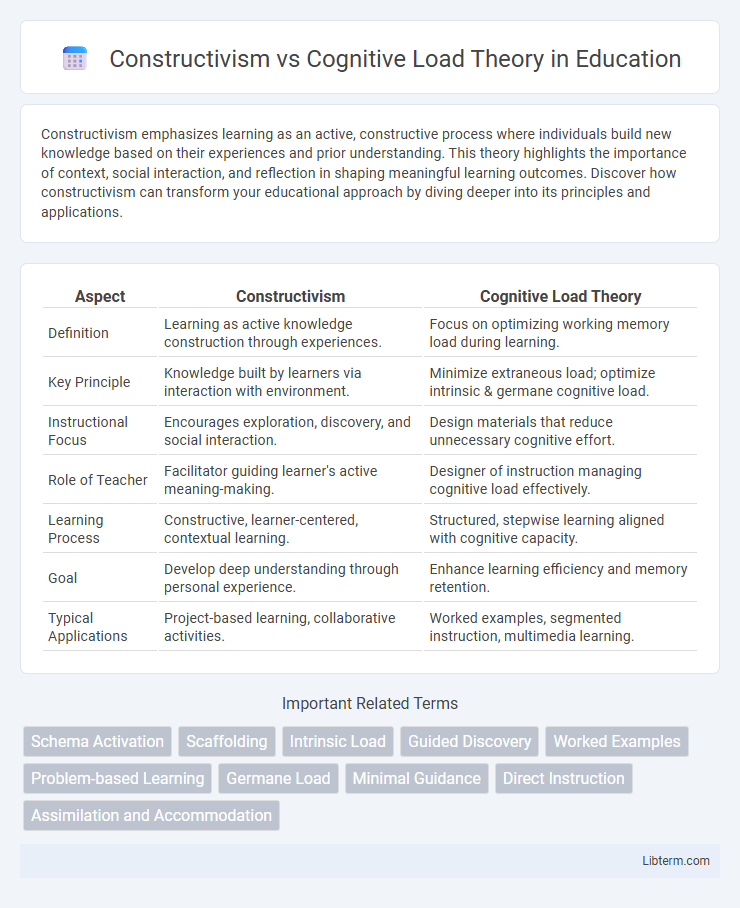Constructivism emphasizes learning as an active, constructive process where individuals build new knowledge based on their experiences and prior understanding. This theory highlights the importance of context, social interaction, and reflection in shaping meaningful learning outcomes. Discover how constructivism can transform your educational approach by diving deeper into its principles and applications.
Table of Comparison
| Aspect | Constructivism | Cognitive Load Theory |
|---|---|---|
| Definition | Learning as active knowledge construction through experiences. | Focus on optimizing working memory load during learning. |
| Key Principle | Knowledge built by learners via interaction with environment. | Minimize extraneous load; optimize intrinsic & germane cognitive load. |
| Instructional Focus | Encourages exploration, discovery, and social interaction. | Design materials that reduce unnecessary cognitive effort. |
| Role of Teacher | Facilitator guiding learner's active meaning-making. | Designer of instruction managing cognitive load effectively. |
| Learning Process | Constructive, learner-centered, contextual learning. | Structured, stepwise learning aligned with cognitive capacity. |
| Goal | Develop deep understanding through personal experience. | Enhance learning efficiency and memory retention. |
| Typical Applications | Project-based learning, collaborative activities. | Worked examples, segmented instruction, multimedia learning. |
Understanding Constructivism: Core Principles
Constructivism emphasizes active learning where individuals construct knowledge through experience and reflection, highlighting the importance of prior knowledge and social interaction in the learning process. Core principles include learner-centered environments, meaningful context, and knowledge construction through exploration and problem-solving. This contrasts with Cognitive Load Theory, which focuses on managing working memory to optimize information processing and instructional design.
Key Tenets of Cognitive Load Theory
Cognitive Load Theory emphasizes the importance of managing intrinsic, extraneous, and germane cognitive loads to optimize working memory during learning. It advocates designing instructional materials that reduce unnecessary cognitive burden, enabling efficient information processing and schema construction. This contrasts with Constructivism's focus on learner-centered knowledge building through active exploration and social interaction.
Historical Evolution of Learning Theories
Constructivism originated in the early 20th century, influenced by Piaget's theory of cognitive development, emphasizing active knowledge construction through experience and social interaction. Cognitive Load Theory emerged in the late 1980s, developed by John Sweller, focusing on the limitations of working memory and optimizing instructional design to reduce extraneous cognitive load. Both theories evolved as responses to the need for effective learning strategies, with Constructivism prioritizing learner-centered discovery and Cognitive Load Theory highlighting the mechanics of information processing in instructional contexts.
Comparing Instructional Approaches
Constructivism emphasizes active learner engagement and building knowledge through experience, fostering deep understanding by connecting new information to prior knowledge. Cognitive Load Theory focuses on optimizing instructional design to manage working memory limitations, reducing extraneous load while promoting germane load to enhance schema acquisition. Comparing these approaches reveals that constructivism encourages exploration and discovery, whereas Cognitive Load Theory advocates structured guidance to prevent cognitive overload during learning.
Constructivism in Classroom Practice
Constructivism in classroom practice emphasizes active student engagement through hands-on learning, collaboration, and real-world problem solving that promotes deep understanding. It encourages learners to build new knowledge by connecting experiences and prior knowledge, fostering critical thinking and autonomy. This approach contrasts with Cognitive Load Theory by prioritizing meaningful exploration over managing cognitive resources during instruction.
Cognitive Load Theory in Lesson Design
Cognitive Load Theory (CLT) emphasizes optimizing lesson design by managing intrinsic, extraneous, and germane cognitive loads to enhance working memory efficiency and promote long-term learning. Effective instructional strategies include segmenting information, using clear and concise language, and incorporating multimedia elements that support schema construction without overwhelming the learner. By contrast with Constructivism, which prioritizes learner-centered exploration, CLT provides structured guidelines to minimize cognitive overload and facilitate knowledge acquisition through well-designed cognitive scaffolding.
Strengths and Limitations of Constructivism
Constructivism emphasizes active learning through experience and discovery, promoting deeper understanding and critical thinking skills by allowing learners to construct their own knowledge. Its strength lies in fostering engagement and motivation, but limitations include potential challenges in providing structure for novices and ensuring accurate knowledge construction. In contrast to the structured approach of Cognitive Load Theory, constructivism may lead to cognitive overload if learners lack sufficient guidance or background knowledge.
Cognitive Load Theory: Advantages and Criticisms
Cognitive Load Theory (CLT) offers the advantage of enhancing learning efficiency by managing working memory constraints through techniques like segmenting information and using worked examples. It supports instructional design by reducing extraneous cognitive load, facilitating schema acquisition, and improving knowledge retention. Criticisms of CLT include its sometimes rigid application that may overlook individual learner differences and the complexity of real-world learning contexts, potentially limiting creativity and deeper understanding.
Applicability Across Educational Contexts
Constructivism emphasizes active learner engagement through exploration and real-world problem solving, making it highly applicable in learner-centered environments such as project-based learning and inquiry-driven classrooms. Cognitive Load Theory focuses on optimizing working memory capacity by managing intrinsic, extraneous, and germane load, proving effective in structured instructional design and multimedia learning contexts. Both theories offer complementary strategies for enhancing learning outcomes across diverse educational settings by balancing hands-on discovery with cognitive efficiency.
Integrating Constructivism and Cognitive Load Theory
Integrating Constructivism and Cognitive Load Theory enhances instructional design by balancing active knowledge construction with manageable intrinsic cognitive load. Constructivist strategies emphasize learner-centered, meaningful experiences, while Cognitive Load Theory guides the optimization of working memory resources through scaffolding and segmenting information. Combining both frameworks results in effective learning environments that foster deep understanding without overwhelming cognitive capacity.
Constructivism Infographic

 libterm.com
libterm.com